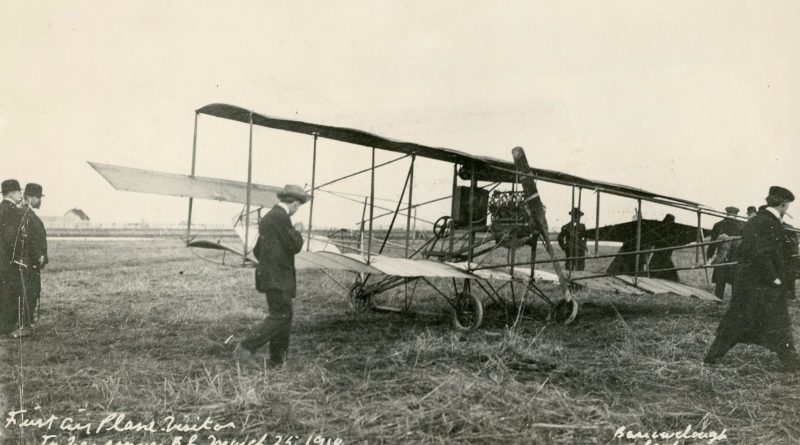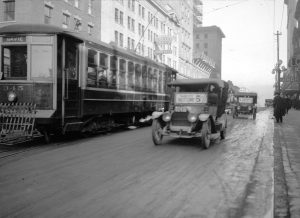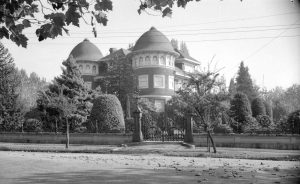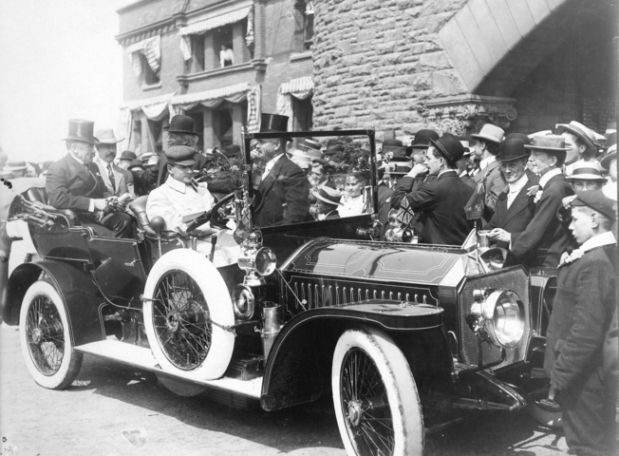
1910 (Sample Chapter)
A note to readers: This is a first draft of the 1910 chapter proposed for the book. It was completed March 20, 2006. By the time the book appears in 2009 it may be much altered.
1910 marked a major event in our history. On March 25 the first airplane flight west of Winnipeg took place at the race track at Minoru Park in Richmond. The news electrified the locals, and some 3,500 people showed up to pack the stands. Flying a Curtiss pusher biplane—the engine was in the rear behind the pilot—was a visiting American aviator, Charles K. Hamilton, who put the little craft through its paces, thrilling the spectators. On the following day, again before a big crowd, Hamilton flew from Minoru to New Westminster and back, returning safely to the race track after 30 minutes in the air—a real achievement for those days. Flushed with success, Hamilton then challenged a racehorse, a local favorite named Prince Brutus, to a one-mile race, and generously gave rider Curley Lewis a head start. The horse won by ten seconds.
Still, the airplane was here to stay and Richmond, with its broad flat lands, would eventually be home to Vancouver International Airport.
Meanwhile, down on the ground, rail continued to play an important role in the growth of the city and its surroundings. From a November 24 newspaper story: “The management of the B.C. Electric Railway Company issued a call for tenders for its new passenger station and office block at the southwest corner of Carrall and Hastings streets . . . The block will cost from $250,000 to $300,000 and the foundations are of such a character that additional stories may be added as the company’s business grows. The ground floor will be devoted almost entirely for use as a terminal passenger station for the interurban systems of the company.” Construction on that building would begin in 1911, and it would open in 1912. It’s an office building today.

Image: City of Vancouver Archives
The interurban continued to have a major influence on settlement here: wherever it went, new neighborhoods popped up. One of the stops on the Vancouver-to-New Westminster line established in 1891 was named Cedar Cottage after Arthur Wilson’s Cedar Cottage Nursery. By 1910 it had become a small village with dozens of stores, its own post office and school (Lord Selkirk, still around). And BCER put through an interurban line this year on the south side of the Fraser River, running from New Westminster through Langley to Chilliwack, intended to bring farm produce from the valley into New Westminster.
The automobile was still a rarity, partly due to a lack of driveable roads. But Harry Hooper, who started Vancouver’s first taxi company this year, excited a lot of attention when he drove his car from Chilliwack to New Westminster, a distance of 48 miles, in just two hours and 10 minutes. That’s an average speed of about 22 miles an hour, a blistering pace compared to one set by the driver of a 1907 Marion in Surrey who was fined $10 for speeding at 12 miles per hour.
New Buildings
“In 1910 Vancouver then will have 100,000 men,” the motto that had been bannered across city streets a few years before, proved accurate—if politically incorrect. The population of the city did reach that total, and the skyline was reflecting it: at the northwest corner of Hastings and Cambie Streets we put up the tallest building in the British Empire. The idiosyncratic 13-storey 175-foot Dominion Trust Building is still one of the most visually distinct in the city, with its red-and-tan exterior and distinctive mansard roof. The architect was J.S. Helyer, about whom a story persists to this day—sometimes, I abashedly admit, passed on by me—that he died in a fall down the building’s central core while on an inspection tour. Alas, as Donald Luxton makes plain in Building the West, his book on our early architects, Helyer would die in bed October 29, 1919.
On February 28, 1910 the city’s new main post office moved to the northwest corner of Granville and Hastings—one block north of its old home at Granville and Pender. The Vancouver World welcomed the new, “the palatial building . . . a landmark, a monument of chiselled stone and massive rounded pillars, that caused the visitor to be impressed with Vancouver’s power and prosperity.” Today, that building, with its famous clock tower, is part of Sinclair Centre, the glossy office and retail complex.
Another famous city clock tops the Vancouver Block, the stocky white terra cotta building put up this year at 736 Granville.
While Francis Rattenbury’s imposing courthouse was being built (1906-1911) a pair of sculpted stone lions were placed in front of it. They were created by John Bruce, a Scot. Each weighed 15 tons, and cost $4,000. They glare out at Georgia Street to this day.
A couple of famous homes were built, too. Southlands, a lavish Marine Drive mansion, was built for the wholesale grocer W.H. Malkin. It was the first built in that area.
And then there was Glen Brae.

Image: Vancouver City Archives
There are people who’ve lived in this area all their lives and never seen Glen Brae, yet this dramatic double-domed giant Shaughnessy mansion has been there on Matthews Avenue for nearly a century. A retired B.C. lumberman named William Lamont Tait built the place, and critical reception to it was mixed right from the start. There are some who think it’s the ugliest house in Vancouver, some who think it’s beautiful. Tait had no doubts at all: he loved it. To set it off properly from its more prosaic Shaughnessy neighbors he had an enormous wrought-iron fence imported from Scotland and placed along the front of the mansion.
A neighbor, Mrs. E.H. Daniel, told Aileen Campbell of The Province many years ago that, as a child, she’d lived in the house next to Glen Brae and saw Tait often: “He was retired when he moved in. He was a great gardener—very proud of his house and wrought-iron fence. He was a great man to say how much things cost. It was brought from Scotland at a cost of $10,000. I remember as a child being very impressed. That was a lot of money . . .”
But that was just the fence. There were 18 rooms in the mansion, one of them a ballroom taking up the third floor. With regard for the tender tootsies of their dancing guests, the Taits had the ballroom floor underlaid with a thick and flexible layer of seaweed. I once walked around on that floor and, even though it was carpeted, could feel it give slightly under my feet.
Tait’s lavish tastes are evident throughout the house. How much of its style comes from him and how much from its architects, Parr and Fee, isn’t recorded. One of the mansion’s six bathrooms has a huge stained-glass window of a sailing scene. There is an attractive three-metre stained glass window in the west wall showing a rural scene somewhere in Ontario.
Today Glen Brae is Canuck Place, a children’s hospice, but much happened in this big, distinctive house before that (it was briefly a home for the Ku Klux Klan), and future pages will tell you more.
Another place devoted to care opened in Vancouver in 1910. In this case, the care was there from the first day. We call it Central City Mission now, but when they laid the cornerstone at 233 Abbott Street—in a driving rain—it was just the Central Mission. Clerics from a number of local churches were there. The Mission, on Pender Street today, has since housed thousands and fed millions.
Future buildings were being planned for, too: in May the provincial government launched a “site commission” to travel throughout the province looking for a good site for the proposed provincial university. They selected the Point Grey peninsula, but it would be 15 long years before UBC opened there.
Some of the city’s future buildings would be designed by an architect named Woodruff Marbury Somervell. He arrived in Vancouver this year from Seattle, where a recession was hitting his trade hard. Among the buildings Somervell would design in the next few years: sugar king B.T. Rogers’ mansion Shannon, the now-vanished Birks Building, the BC Electric building at Hastings and Carrall and the T-D Bank at Hastings and Seymour.
The PNE
There was a lot of building going on, too, over at Hastings Park. The Pacific National Exhibition—its name at the beginning was simply the Vancouver Exhibition—might have opened earlier than 1910 if it hadn’t been for the Royal Agricultural Show in New Westminster. That annual fair had been running for years, and New West tried to stall the creation of a competing fair in Vancouver. It didn’t work. Pressure from Vancouverites made the PNE inevitable.
Years later Alderman J.J. Miller, who’d been the first president of the exhibition association, reminisced about the birth of the fair: “The facilities for transportation [in 1910],” Miller wrote, “were not equal to the task of transporting the population of the growing City of Vancouver to New Westminster. The B.C. Electric Railway had but a single track connecting the two cities with a very limited number of interurban cars. The Canadian Pacific Railway on Exhibition days ran a special train made up of all kinds of rolling stock, passenger and freight, via Westminster Junction [now Port Coquitlam]. There was no highway, no automobiles, no buses.
“With all the available means of transportation,” he continued, “not one half of the population could be handled. The expense also was great and the cost to a family excessive. The idea of an Exhibition located within the reach of a five-cent car fare to the population of the big City of Vancouver gained ground, and in 1908 definite steps were taken . . .”
Two years of hard work by Miller and others followed until August 15, 1910—the informal opening date—when the gates to the Exhibition were thrown open and the crowds poured in. The official opening was the next day, and the man who presided was the prime minister, Sir Wilfrid Laurier. This was in a day when the visit of a prime minister thrilled the citizens.

That’s the prime minister in the derby just behind the white-coated driver (note the right-hand drive) of that beautiful automobile, a Napier. The top-hatted mustachioed gentleman on the left is Ewing Buchan, president of the Vancouver Canadian Club and manager of the local branch of the Bank of Hamilton. The hatted man in the light suit between Laurier and Buchan is Vancouver’s mayor, L.D. Taylor. (This was Taylor’s first term as mayor. Many, many more would follow!) The photo was taken at the north foot of Granville Street, by the CPR station where Sir Wilfrid had just arrived by train.
The opening day crowd at the Exhibition was large: about 5,000. (Admission was 50 cents.) The organizers hadn’t been expecting anything like that number. Manager Henry Sharpe Rolston later recalled what that first day was like: “The arrangements for the first fair were very inadequate, particularly the handling of the crowds . . . Many of the directors tried to handle the crowds at the gates. The fence was knocked down; we collected cash and let the people in, put the cash in our pockets and emptied our pockets at the office. Everything was in a turmoil . . .”
The Vancouver Daily News-Advertiser wrote, “Petrified women, sacrificial crocodiles from the sacred river Ganges, and dusky negroes who dodge swiftly thrown baseballs, to say nothing of the numerous Salome dancers, Spanish Carmens, Dutch comedians and chorus girls are some of the attractions being offered the visitors at the fair this week.”
Over the next 10 days, some 68,000 people attended. The turmoil was solved, and for the next two decades the Vancouver Exhibition was the second largest in North America after New York City’s.
The Church
The work of the church continued, of course. For the Catholics, the Oblate Fathers opened their third Vancouver church, this one on East 12th Avenue just west of Main Street in Mount Pleasant. Today, that church, St. Patrick’s, has been replaced with a newer and bigger building just around the corner and facing onto Main Street. Knox Presbyterian Church began services in Wilson Road (West 41st Avenue) School in the Southlands district, would build its church in 1911. And an Anglican Church conference held in London, England this year awarded a grant to establish a theological college in Vancouver. They called it Bishop Latimer College, named for a 16th century English martyr, and put it at 1548 Haro Street. Today, it’s on the UBC campus.
Ecumenism was alive: the Associated Charities of Vancouver started a West End Creche (as child-care facilities then were called) this year.
And one of Burrard Inlet’s lasting landmarks was introduced this year when Sacred Heart Catholic church, consecrated in 1884 at Ustlawn village, the Indian mission village in North Vancouver, had a second spire added during renovations, and was rededicated as St. Paul’s. Those twin spires have graced the north shore skyline for the better part of a century.
B’Nai Brith began in Vancouver this year with the establishment of Samuel’s Lodge #668. (The Canadian section of B’nai Brith was founded in1875, the country’s oldest Jewish service organization.)
O Canada
Ewing Buchan’s name appeared earlier in this chapter. Thanks to Buchan, many people believe that O Canada, Canada’s national anthem, was written in Vancouver. If only it were so.
Buchan’s brother, Brigadier-General Lawrence Buchan, stationed in Quebec, had sent him a copy of the music, composed in 1875 by Quebec’s Calixa Lavallée. Ewing Buchan was very taken by the air, and he and his family often sang it in their home at 1114 Barclay St. Daughter Olive provided the piano accompaniment. But Buchan was dissatisfied with the English translation of the French words to the tune and decided to write his own, a single stanza.
The opening four notes suggested to Buchan an obvious first line: “O Canada.”
The same two words began the French lyrics to the song. The air’s first four notes, in fact, inspired a small mob of Canadians outside Quebec to begin their versions of the song with the same two words. (A Toronto-based magazine offered a prize for the best three-stanza song in English, set to the Lavallée air, and got 350 entries.)
At the urging of Vancouver city archivist Major J.S. Matthews, Buchan’s son Percy wrote a pamphlet on his father’s creation of those now forgotten lyrics.
“It happened,” Percy wrote, “that in 1908-09 my father was second vice-president of the Canadian Club of Vancouver. The custom of the club was to open its luncheon proceedings with a toast to the King (Edward VII), followed by singing of the National Anthem, God Save the King, and to close with the first verse of The Maple Leaf Forever. Having O Canada in mind, he resolved to urge its substitution for The Maple Leaf Forever at all functions of the club and to that end devoted a considerable part of his leisure during the winter evenings of 1908 to quiet reflection on the matter . . . The song had its introduction at the close of a luncheon meeting (of the Vancouver Canadian Club) on Wednesday, February 9, 1910, in old Pender Hall, situated on the upper floor of the present two-storey building at the southwest corner of Pender and Howe streets. [He’s writing this in 1947] . . . Eventually it became the custom of the club to close its meetings with the singing of O Canada instead of The Maple Leaf Forever.”
Supporters of the Buchan version would distribute some 40,000 copies to Vancouver school children and keep up steady (but eventually unsuccessful) efforts on its behalf for years. For the record, here are the words to “the Buchan version” of O Canada:
O Canada, our heritage, our love
Thy worth we praise all other lands above
From sea to sea, throughout thy length,
From pole to borderland
At Britain’s side, whate’er betide,
Unflinchingly we’ll stand.
With heart we sing, “God Save the King”
“Guide thou the Empire wide,” do we implore
“And prosper Canada from shore to shore.”
Canada mourned May 6 when King Edward VII died. The Vancouver chapter of the IODE (Imperial Order Daughters of the Empire) commissioned a fountain from sculptor Charles Marega in tribute to Edward. Today it stands next to the Art Gallery on the east side of Hornby Street. Edward was succeeded by George V.
Showbiz
Despite its relatively small size (about 150,000 at the time) Metropolitan Vancouver began to attract world-class entertainment personalities. On November 17, 1910 Anna Pavlova, the most famous dancer who ever lived, danced in Vancouver as part of a North American tour. It was her first visit here, and the audience went gaga. The Province review of her performance went beyond rave, flirted with worship.
That’s Mikhail Mordkin with Pavlova in a photo taken during that tour. Pavlova returned the city’s enthusiasm. She described her first visit to the city (she would make two more) in a short autobiographical note: “We stayed at little towns in Canada; at Vancouver among other places. An incident which took place there, although trifling, amused me greatly; it illustrates the delightful courtesy of the Canadians.” While Pavlova dined at a restaurant after her performance, “a gentleman who was seated at another table stood up and in an extemporized speech asked all present to drink my health . . . all responded to the invitation and drained their glasses in my honor.” That incident made the Seattle newspapers, Pavlova noted, and, not to be outdone, the locals there paid her a similar compliment.
One tiny memento of her appearances in Vancouver came to light in a curious way many years after she died. It happens that, during one of her later visits here, she had performed at the now-vanished Empress Theatre at Gore and Hastings. As they were tearing that theatre down in 1940, one of the workmen noticed a flash of soft color in the debris. He reached down and picked up a tiny powderpuff. Stitched on it, in faded golden letters, was a single word: Pavlova.
Another showbiz personality in Vancouver this year was an itinerant young English would-be actor, aged about 23, named William Pratt. Acting jobs were scarce, and he got a part-time job here as a carpenter at the Vancouver Exhibition. Later Pratt would move to Hollywood and change his name to Boris Karloff. The PNE was partly built by Frankenstein’s monster.
The Navy
The excitement of the Pavlova visit done, a few days later another visitor got local hearts racing. The second ship of the Royal Canadian Navy, HMCS Rainbow, a 3,000-ton cruiser, steamed into Vancouver’s harbor on November 23rd. Photo She was the first RCN warship to visit the port, and the city gave her and her 189 crew members a big welcome. Other ships dipped their flags and blew their sirens, and Mayor Taylor and his council went out “in the city’s state barge” to welcome the ship. (The Province explained that the “state barge” was, in fact, the “waterworks launch with Steve Madison at the wheel.”) The Rainbow was not a new ship; she’d been launched in 1891 at Jarrow-on-Tyne, England for the Royal Navy.
Business
A Bank of Vancouver was established, but it would go into liquidation just five years later, because it could not attract a significant deposit base.
Columbia Bitulithic was founded this year and headquartered in Coquitlam. The company built roads throughout the province and was responsible for a lot of the Vancouver road network.
The first B.C. Federation of Labour was formed. Twenty-six delegates, mainly from the Lower Mainland, pledged to seek the eight-hour day, favored industrial unionism and endorsed socialism. This federation would be disbanded in 1920.
The McElhanney engineering firm was established this year by W.G. McElhanney, professional engineer and land surveyor. Today, the McElhanney Group of companies is a very large, multi-disciplined firm with offices in western Canada and Indonesia.
Woodward’s held its first one-price sale day, 25 Cents Day, a forerunner of $1.49 Day.
Fragments
The map of the lower mainland was due for a change: Hastings Townsite ratepayers voted December 21 to join Vancouver, effective January 1, 1911. The townsite was a big chunk of land. Superimposed on a map of the city today, it would stretch from Burrard Inlet to East 29th Avenue between Nanaimo Street and Boundary Road.
An important name on the map changed, too: Westminster Avenue—so named because it led to New Westminster at the time—became Main Street. (Its original name had been False Creek Road.)
Riverview Psychiatric Hospital opened in Coquitlam as the Hospital for the Mind, including Colony Farm, operating out of a hay barn on1,000 acres. Sixty patients were admitted the first year, working on the farm to provide food for themselves and staff.
Sculptor Charles Marega created a bust of former mayor David Oppenheimer near the entrance to Stanley Park. (Oppenheimer had presided at the 1889 opening of the park.)
A visitor to Vancouver’s east side reported that a “Piccola Italia,” or Little Italy, had been established in the area around present-day Main Street. There were about 1,000 Italians in Vancouver at the time.
The Canadian Immigration Act specifically barred immigrants from India.
The wood-hulled, steam-powered tug Haro was built in Vancouver for B.C. Mills (Hastings Mill) for its harbor service.
Bob Brown, the man who would become known here as “Mr. Baseball,” bought the Vancouver Beavers for $500. He was the club’s owner, president, manager and shortstop.
James Edwin Machin, Vancouver’s first librarian, died March 31.
Vancouver’s police began agitating this year for a six-day week. The request was shelved, and the seven-day week continued.
Top image: Charles K. Hamilton made the first airplane flight in British Columbia at Minoru Park Racetrack on March 25, 1910 in this Curtiss biplane. As can be seen in this photo, the aircraft had a hard landing on the infield of the track, bending one of the landing wheels, but was repaired and carried on with its demonstration. (City of Richmond Archives photograph 1978 15 18)
